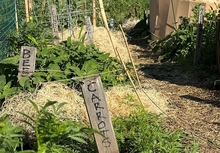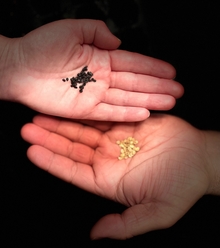A food co-op board member reflects on collaborating with U of M Extension Master Gardener volunteers
Laura Medwetz told me she got so excited at the first annual spring seed swap hosted by the Just Food Co-op in Northfield that she got goosebumps.
Medwetz and Margaret Huber, both University of Minnesota Extension Master Gardener volunteers, worked the event with me on a cold, gray day in March. It was the perfect time to be inside, gathering with other gardeners and dreaming of homegrown veggies.
Today, those dreams are well on their way to fruition.
Planning early
I’ve swapped seeds with my friends for years, but I’d never organized an official seed swap before. I thought it would be a fun event that dovetailed nicely with our mission at the Just Food Co-op.
Seeking advice, I reached out early to the Master Gardeners in Rice County. The response was much more enthusiastic than I expected.
“We used to do a plant swap with our group and the Northfield Garden Club, just amongst ourselves, and for whatever reason it stopped happening,” says Jayne Spooner, who has served on Extension’s Master Gardener advisory board.
Plant swaps have dwindled in recent years with the spread of invasive jumping worms. Seeds — in small quantities that can be easily identified — are a safer way to share.
“The Northfield Public Library told us they tried to do a seed library, but they had trouble with people not leaving any, only taking them,” says Kim Reis, a Master Gardener in Northfield. “They also said they struggled to find people to keep it organized and stocked.”
Medwetz and Huber both quickly volunteered their time and gardening expertise.
With the support of the Just Food Co-op staff and board, the Extension Master Gardeners, and some tips on how to plan an event on the Seed Savers Exchange website, it all started coming together.
“These are exactly the kinds of projects the Master Gardeners love to be involved with,” says Lorrie Rugg, Extension Master Gardener coordinator in Rice and Steele counties. “We like to get seeds in the hands of people that need and want to grow fresh food.”
The group decided to gear the event toward edible foods since that is what our co-op prioritizes. We created additional guidelines, like deciding not to accept donated seeds older than one year. The logistics of sharing tiny seeds can be a struggle, but a local Buy Nothing group donated 200 mini envelopes.
I like to keep my seed packets so I can refer back to the information on them throughout the growing season. So we encouraged people to take photos of the original seed packets with their phones and label the little envelopes with which seeds they took home.
The big day
As gardeners dropped off their donated seeds, the volunteers sorted those packets under signs that I made for veggies, herbs and flowers. The second hour of the event was all about selecting which seeds to take home.
“It was so fun to talk to other gardeners, connecting over conversations about seeds and favorite plants,” says Huber.
The seed swap brought in all types, from curious kids and others new to gardening to very experienced gardeners.
Some quietly dropped off their seed donations on their way to do some grocery shopping, while others stayed and chatted, strategizing over their selections. The whole thing just felt really good — all the way through the end, when we donated the remaining seeds to the Community Action Center Food Shelf.
“I can only imagine it will get bigger and better next year,” says Rugg. “A very successful day was held with many satisfied customers.”
“The seed swap was a perfect opportunity to connect with the community, make new friends and share a love of gardening,” says Medwetz.
It’s a day we all look back on with pride as gardens in our community hit their summer growth spurt.
Seed swap planning tips
- Connect with local Extension Master Gardener volunteers. They’re a great resource.
- Host your seed swap about 10 weeks before last frost (mid-March for southern Minnesota).
- Sow the idea, spread the word and watch it grow. Reach out to local interest groups of all ages in person and on social media.
- Think about supplies you might need, like small envelopes, paper plates for sorting, tape, pens and signage.
Permission is granted to news media to republish our news articles with credit to University of Minnesota Extension. Images also may be republished; please check for specific photographer credits or limited use restrictions in the photo title.




